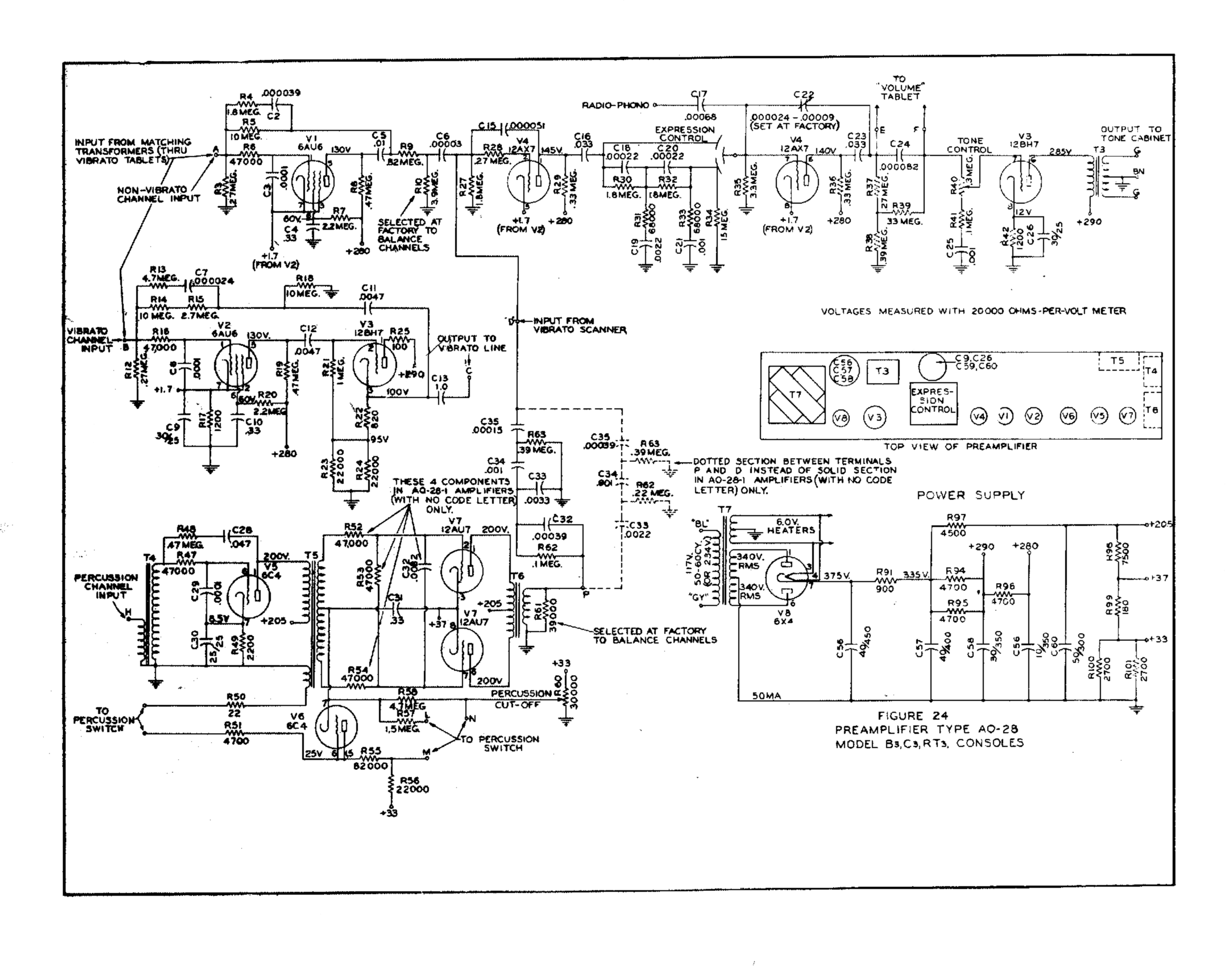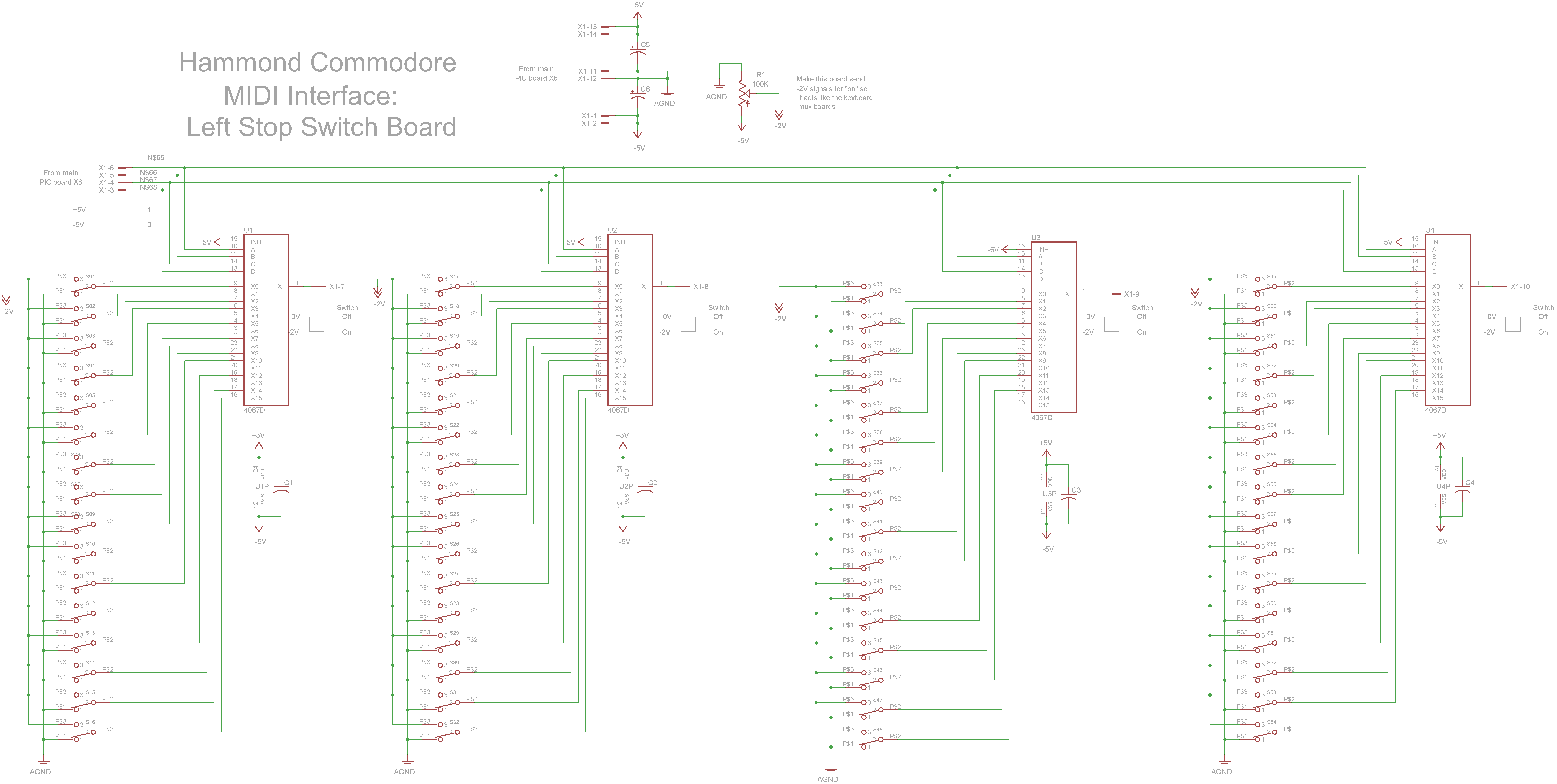
Hammond T-100/T-200/T-500 MIDIvice

A MIDI interface designed for automatic accompaniment or controlling a MIDI expander. MIDIvice supports both manuals and includes various program features. It functions as a MIDI output interface for the upper and lower manuals, utilizing an economical 8031 microcontroller and single-sided PCBs. Some PCB etching is required. This is the T-Series MIDIvice, currently in beta testing. It scans both keyboards, transmitting MIDI on different channels and features a straightforward two-button user interface. The total cost for parts will not exceed $40. Wiring is minimized to five wires for each manual. Users can select from 44 General MIDI (GM) program setups by pressing a pushbutton and one of the manual keys. The default MIDI program change sequences (256 bytes per setup) stored in EPROM can be customized. Schematic diagrams, printed circuit layouts, and EPROM HEX files are available as freeware. The MIDIvice system comprises three main components: the MIDIvice Controller Board, the Keyscan Units (one PCB for every eight keys, requiring 12 boards for a spinet organ), and a simple user interface panel. Wiring is simplified due to the serial 5-wire interface to the keyscan units, which fit neatly behind the key combs. The MIDIvice PCB layout PDF can be downloaded for board etching. Instructions for etching a PCB from a printed layout are widely available, though this project is not recommended for beginners. A transformer must be replaced with a 117V type for users in the US. Caution is advised as dangerous voltages are present on the board when connected to mains power. For the freeware version 1.01 of MIDIvice, components IC6, IC7, IC8, MIDI in, lithium battery, and extension connector (marked in red) should be omitted when assembling the PCBs. The EPROM 27C256 (IC5) must be programmed with the MIDIvice spin44 firmware 1.01. For the improved shareware version or to obtain a programmed EPROM (for $10 plus shipping), users can follow the "Buy Now" link or contact the developer. Percussion or brush contacts (the first row of contacts under the manual keys) can be connected directly to the Keyscan Units without removing the attached 220kΩ resistors. The lower manual can be positioned for easier access by loosening its screws and tilting it down. PCBs can be mounted using hot glue to adhere them to the sheet metal frame, with a thin spacer strip to prevent short circuits. It is essential to connect the busbar wire to a ground pin on one of the Keyscan Units. Five wires from the last lower Keyscan Unit lead to the MIDIvice Controller Board, separated for each manual. MIDIvice provides an output for single-trigger percussion on T-Series organs, as the percussion contacts in the upper manual are utilized for MIDI scanning. The red/white percussion busbar cable from the Hammond percussion board should be reconnected to the percussion output of the MIDIvice Controller Board with a 47kΩ resistor in series, eliminating the need for a separate percussion modification circuit. MIDIvice transmits on two consecutive MIDI channels (with a jumper-defined Base Channel for the upper manual and Base Channel +1 for the lower manual). Future versions will include Base Channel +2 for bass pedals. Four jumpers on the MIDIvice controller board configure the base octave and channel settings, as indicated in the schematics. The default MIDI channel for the upper manual is set to 1 (with the lower manual at +1 = 2), and the default MIDI note for the lower manual is 0x1D (F1), while for the upper manual, it is 0x29 (F2). The MIDIvice features a simple two-pushbutton user interface. Pressing the "ProgChange" momentary switch activates an adjacent LED and awaits a key press from the lower manual. For example, pressing the first F key on a spinet manual sends a MIDI Program Change for program 1.A MIDI interface for an automatic accompaniment or controlling an MIDI expander. MIDIvice supports both manuals and has some nifty program features. It`s a MIDI output interface for upper and lower manual, working with a dirt-cheap 8031 and single-sided PCBs only. Some PCB etching required. This is my T-Series MIDIvice, now under beta testing . It scans both keyboards, sending MIDI on different channels and has a simple two-button user interface. It works with a dirt-cheap 8031 and single-sided PCBs - total cost will not exceed 40 US-$ for parts.
Wiring is reduced to a minimum of 5 wires to each manual. You can choose one of 44 GM program setups by simply pressing a pushbutton and one of the manual keys. You may change the default MIDI program change sequences (256 Bytes per setup) stored in EPROM to your own needs.
Best of it: You will find schematics, printed circuit layout and EPROM HEX file here - it`s freeware! Interested First download the complete MIDIvice 1. 0 schematics. MIDIvice consist of three major parts: The MIDIvice Controller Board, the Keyscan Units (you need one PCB for each 8 keys, i.
e. 12 boards for a spinett organ) and a very simple "user interface" Panel. Wiring is extremely easy due to the serial 5-wire-interface to the keyscan units which fit snugly behind the key combs (see right picture above). Download the MIDIvice PCB layout PDF and etch boards as needed. Instructions how to etch a PCB from a printed layout can be found around the web, but I suppose you have already done this before.
I do NOT recommend this as a beginner`s PCB etching project! The transformer has to be replaced with a 117V type for those living in US. Warning: There are dangerous voltages present on the board when connected to mains power! For the freeware version 1. 01 of MIDIvice, omit IC6, IC7, IC8, MIDI in, lithium battery and extension connector (parts marked red) when furnishing the PCBs. The EPROM 27C256 IC5 has to be programmed with the MIDIvice spin44 firmware 1. 01 ; If you want the improved shareware version or need a programmed EPROM (10$ plus shipping), simply follow the "Buy Now" link below or drop me a line.
Percussion or brush contacts (first/upper row of contacts under the manual keys) may be connected directly to the Keyscan Units without removing the attached 220kOhm resistors. You may bring the lower manual in a working position by loosening it`s screws and tilting down so it is very easy to access.
I mounted the PCBs by simply glueing them to the sheet metal frame with hot glue, using a thin spacer strip to prevent short circuits. Don`t forget to connect the busbar wire to a ground pin of one of the Keyscan Units. 5 wires of the last lower Keyscan Unit lead to the MIDIvice Controller Board, separately for each manual.
MIDIvice provides an output for single-trigger percussion on T-Series organs, since the percussion contacts in the upper manual are used for MIDI scanning. Just reconnect the red/white percussion busbar cable from the Hammond percussion board to the /Persussion output of the MIDIvice Controller Board with a 47kOhms resistor in series.
So you don`t need my percussion modification circuit. MIDIvice transmits on two consecutive MIDI channels (jumper-defined Base Channel on upper manual, Base Channel +1 on lower manual). Future Versions will provide Base Channel +2 for bass pedals. Four jumpers on the MIDIvice controller board set the base octave and channel configuration - see schematics.
Default (=no jumper) MIDI upper manual channel is 1 (lower manual +1 = 2), default MIDI note on lower manual is 0x1D (F1), on upper manual 0x29 (F2). MIDIvice uses a simple two pushbutton "user interface". Pressing the "ProgChange" momentary switch blinks the adjacent LED and waits for a single key (lower manual) to be pressed.
Pressing the first F key on a spinett manual sends out MIDI Program Change to program 1. If you deci 🔗 External reference
Wiring is reduced to a minimum of 5 wires to each manual. You can choose one of 44 GM program setups by simply pressing a pushbutton and one of the manual keys. You may change the default MIDI program change sequences (256 Bytes per setup) stored in EPROM to your own needs.
Best of it: You will find schematics, printed circuit layout and EPROM HEX file here - it`s freeware! Interested First download the complete MIDIvice 1. 0 schematics. MIDIvice consist of three major parts: The MIDIvice Controller Board, the Keyscan Units (you need one PCB for each 8 keys, i.
e. 12 boards for a spinett organ) and a very simple "user interface" Panel. Wiring is extremely easy due to the serial 5-wire-interface to the keyscan units which fit snugly behind the key combs (see right picture above). Download the MIDIvice PCB layout PDF and etch boards as needed. Instructions how to etch a PCB from a printed layout can be found around the web, but I suppose you have already done this before.
I do NOT recommend this as a beginner`s PCB etching project! The transformer has to be replaced with a 117V type for those living in US. Warning: There are dangerous voltages present on the board when connected to mains power! For the freeware version 1. 01 of MIDIvice, omit IC6, IC7, IC8, MIDI in, lithium battery and extension connector (parts marked red) when furnishing the PCBs. The EPROM 27C256 IC5 has to be programmed with the MIDIvice spin44 firmware 1. 01 ; If you want the improved shareware version or need a programmed EPROM (10$ plus shipping), simply follow the "Buy Now" link below or drop me a line.
Percussion or brush contacts (first/upper row of contacts under the manual keys) may be connected directly to the Keyscan Units without removing the attached 220kOhm resistors. You may bring the lower manual in a working position by loosening it`s screws and tilting down so it is very easy to access.
I mounted the PCBs by simply glueing them to the sheet metal frame with hot glue, using a thin spacer strip to prevent short circuits. Don`t forget to connect the busbar wire to a ground pin of one of the Keyscan Units. 5 wires of the last lower Keyscan Unit lead to the MIDIvice Controller Board, separately for each manual.
MIDIvice provides an output for single-trigger percussion on T-Series organs, since the percussion contacts in the upper manual are used for MIDI scanning. Just reconnect the red/white percussion busbar cable from the Hammond percussion board to the /Persussion output of the MIDIvice Controller Board with a 47kOhms resistor in series.
So you don`t need my percussion modification circuit. MIDIvice transmits on two consecutive MIDI channels (jumper-defined Base Channel on upper manual, Base Channel +1 on lower manual). Future Versions will provide Base Channel +2 for bass pedals. Four jumpers on the MIDIvice controller board set the base octave and channel configuration - see schematics.
Default (=no jumper) MIDI upper manual channel is 1 (lower manual +1 = 2), default MIDI note on lower manual is 0x1D (F1), on upper manual 0x29 (F2). MIDIvice uses a simple two pushbutton "user interface". Pressing the "ProgChange" momentary switch blinks the adjacent LED and waits for a single key (lower manual) to be pressed.
Pressing the first F key on a spinett manual sends out MIDI Program Change to program 1. If you deci 🔗 External reference




